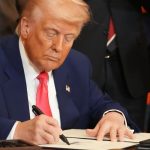Not a month after one of the largest cryptocurrency selloffs, in which $3.62 billion in long positions were wiped out, the sector has outdone itself. On October 10, nearly $20 billion disappeared. To make it sting even more, this happened in October, the month when crypto traders usually toast for good luck.
Here’s how it happened. Last week, President Trump decided to throw another grenade across the Pacific, announcing via Truth Social a 100% tariff on all Chinese imports starting November 1, coupled with new export controls on critical U.S. software. It was the most aggressive move since May’s fragile truce, marking a sharp break from earlier rhetorical threats that had been watered down or delayed.
Normally, such statements barely move the needle. But this one landed. No exceptions, virtually no delays and, most importantly, it was accompanied by new export controls on critical US software, which the market interpreted as a real policy change rather than a negotiating tactic.
That suggested Washington was ready to weaponize technology and trade in tandem, just after China imposed drastic export controls on rare earth minerals, a moment that made the U.S. response look retaliatory and amplified the sense that the trade truce was truly over, a move that rattled every risk asset from stocks to Bitcoin.
Traditional vs. Challenge
Wall Street was able to close up shop and go home for the weekend. Crypto couldn’t. Trading continued, turning the weekend into a fire drill for the global market.
The setup was classic hubris. Too many overleveraged long bets, too many traders convinced the charts were their friends. I met the chief investment officer of one of our portfolio funds, Vadim Khramov of Edge Capital, for coffee shortly after. The company team summarized the situation clearly.
This sell-off was unprecedented in scale, with many tokens falling by more than 50%. Market liquidity was severely strained by the adjustment and temporary de-indexing of the stablecoin USDe on Binance, which triggered a cascade of liquidations on smaller altcoins, or alternative coins, as margin requirements briefly changed.
Despite the volatility, decentralized finance (DeFi) has demonstrated remarkable resilience. Smart contracts worked as expected, liquidations were executed efficiently, and no major deregulations or bad debts appeared on major lending platforms. The roughly $100 billion DeFi lending market has absorbed the shock remarkably well.
Feedback from several funds of funds confirmed that institutional managers handled the event effectively, with no major liquidations or bankruptcies reported. The overall environment remained stable, with no signs of systemic risk, bankruptcies or structural weaknesses across the sector.
The abrupt deleveraging eliminated excess debt, reduced short-term risk and left the market on healthier footing. Although some market makers and smaller funds have been affected, particularly those focused on small-cap tokens or mean reversion strategies, the hedge fund industry as a whole has weathered the storm well. The episode highlighted both the growing maturity of institutional digital asset managers and the robustness of DeFi infrastructure under pressure.
Then came Binance. The world’s largest stock exchange saw its liquidity disappear for two minutes. Don’t thin out, fade away. Imagine the Intercontinental Exchange suddenly refuses to quote oil prices. For traders cross-arbitrageing, buying on one site and selling on another to close a price gap, those two minutes seemed like an eternity. They were trapped, unable to unwind their trades or even cover their exposure.
The result was a pricing black hole that rippled through every trade. Stop loss orders, automated triggers to limit losses, triggered in rapid succession. Margin calls hit accounts that couldn’t replenish their collateral quickly enough, and the cascade fed itself until liquidity returned.
What is to blame
The irony is that smart contracts have held up better than human infrastructure. While centralized systems choked, DeFi continued to function. Smart contracts did what they were designed to do: verify, trigger, execute. No courtrooms, no judging, just code. It was a quiet advertisement for what the technology is supposed to represent.
Warren Buffett once said that when the tide goes out, you find out who swam without a swimsuit. This time much of the beach was bare. About $500 billion in market capitalization has disappeared. Small traders have been hit hardest. Automatic position closures, instant liquidation of accounts at the worst possible moment, without mercy or appeal. Some exchanges collapsed and reversion bots continued to feed cash into a shredder.
The lesson? The problem with cryptography was not the technology but the infrastructure around it. Smart contracts and DeFi rails worked exactly as they should, but centralized exchanges did not. A momentary failure of a too-big-to-fail site like Binance was enough to drag the market down.
The incident proved once again that even if the code was solid, the human and operational layers still introduce fragility. Crypto’s plumbing requires constant work, and that probably always will be the case. Flash crashes in global markets are nothing new, whether caused by leverage, algorithms, or simple system failures. They remind us that financial progress never completely escapes human error, it simply changes form.
A flash crash is a sudden, sharp drop in asset prices that occurs within seconds or minutes, usually followed by a rapid recovery. This happens when liquidity temporarily disappears – either because algorithms pull quotes, market makers halt trades, or systems misfire – creating a vacuum in which small sell orders trigger outsized price swings.
Some examples. The flash crash of U.S. stocks in 2010, when the Dow plunged nearly 1,000 points in a matter of minutes. Then there was the Ethereum flash crash on Coinbase in 2017, when ETH, Ethereum’s native cryptocurrency, briefly fell from around $320 to 10 cents due to a cascade of automated liquidations.
Still, the data puts the moment into perspective. This is the largest liquidation in nominal terms, but the three largest events, including April and May 2021, are all within inches of each other when compared to total market value. In percentage terms, this shake-up ranked first with around 0.47 percent of the global crypto market cap, barely ahead of 2021’s 0.45 percent and 0.44 percent events. In other words, this is normal for a maturing market. Bigger base, bigger waves.
Far from being a sign of fragility, this shows how far the ecosystem has developed. The same proportion of suffering now translates into much larger nominal sums. These episodes will continue to happen, not because crypto is broken, but because it functions as a real market, which now moves with global macroeconomic events rather than its own internal drama. The more capital, infrastructure, and participants the space attracts, the more natural these occasional collapses become. This is a feature, not a flaw, and a sign of how far the asset class has come.
Yevgeny Bebnev is chief investment officer at Pelican Investments










